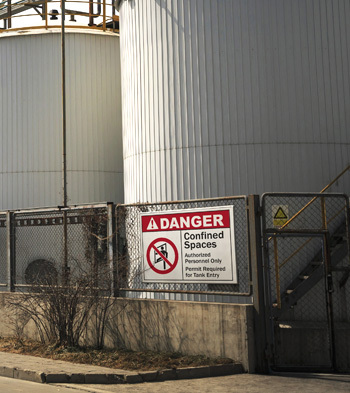Improve Safety Inside and Around Storage Tanks
03
February,
2023
2 MINUTE READ

A recent article by IndustryNet discusses the COVID-19 trends that are having an impact on U.S. industrial storage tank manufacturers. These trends include a reduction in restaurant and agricultural demands, and a lower demand for oil. As industrial use for storage tanks increases, workers need to understand how to stay safe when working in or around them.
There are many types of industrial storage tanks and they have a variety of uses. There are above and underground tanks for fuel and other chemicals, septic tanks, and food storage tanks, among others. Workers need to enter confined spaces for routine maintenance, repairs, inspection, and to retrieve objects. For spaces such as grain bins, workers often will enter to break up chunks of product or to help pack down products.
Common Failures
According to the Bureau of Labor Statistics, there is an average of 92 fatalities per year from confined spaces. Firefighters and other would-be rescuers make up 60 percent of confined space fatalities, according to the Occupational Safety and Health Administration. During investigations of confined space incidents, reports show a common lack of written confined space entry procedures, insufficient training, no rescue plan, and no testing before entry or proper ventilation.
Recently, a manufacturer in Texas received OSHA citations for exposing employees to amputation, confined spaces, and other safety hazards in and around storage tanks. The report shows the company did not have a confined space permit system or adequate respiratory and hearing protection, situations that could cause a severe injury or death.
"Employers must recognize the safety and health risks inherent to their work operations and environment and take necessary precautions to protect workers who perform those operations," said Loren Sweatt, OSHA principal deputy assistant secretary of labor. The permit process ensures that due diligence has been followed in considering the hazards of a confined space. Workplaces can find an example permit for certified confined spaces in Appendix D of subpart J in OSHA's 1910 Safety Regulations.
Improve Safety
Modern or old, storage tanks still have work hazards including fire, entrapment, asphyxiation, ladder and other falls, shock, and chemical hazards. Properly working in or around storage tanks requires a solid workplace safety program that adheres to safe and efficient best practices. There are several ways workplaces can reinforce storage tank safety for worker health as well as compliance for confined spaces.
-
Inspect and evaluate the space: Use a thorough job hazard analysis before any work in a storage tank. Use a pre-entry checklist. Go over the hazards and tasks that need completion with workers and plan accordingly. Look for alternatives to any dangerous work. Use a confined space permit system when entry is needed in a hazardous confined space.
- Increase visibility: Confined spaces often are tight, with limited or restricted points of entry and exit. This often attributes to low visibility when a worker is performing work in narrow diameters. If a designated spotter is responsible for holding a flashlight, what happens if they need to respond to an accident?
- Communicate: Have a written permit-required confined space program. Identify permit required and other confined space dangers through quality warnings such as high visibility signs and labels.
- Use proper tools and personal protective equipment: Monitor the atmospheric conditions of the space and use gas-monitoring equipment. Use appropriate gloves, respirators, earplugs, eye protection, and other protective clothing or gear. Consider the temperature and workers' needs for space. Ensure workers have the appropriate fall protection.
- Continuous training: Make sure workers understand and stay on top of confined space safe practices, including lockout tagout and machine guarding. Conduct regular safety and educational meetings where workers can ask and answer questions.
- Emergency planning: Preplan with local responders for confined space safety and rescue. Post reminders of emergency response protocol and include contact phone numbers.
When developing, maintaining, or improving safety plans in and around storage tanks, workplaces consider all steps and plans. Provide workers with thorough documentation of the necessary controls, responsibilities, and expectations. Continually review any workplace safety program and identify areas to improve.
RELATED RESOURCES

Partnerships Pull Together for Grain Bin Safety
Over the past several years, the number of grain bin injuries and deaths have improved, but only slightly. ...
Read
OSHA Issues Confined Spaces in Construction Standard Guide
OSHA has published a new training resource to help small businesses comply with the 2015 Confined Spaces in ...
Read
MSHA Issues New Rule for Proximity Detection
Detection systems are used to help protect miners from being crushed or pinned in confined underground mine ...
Read.png)


